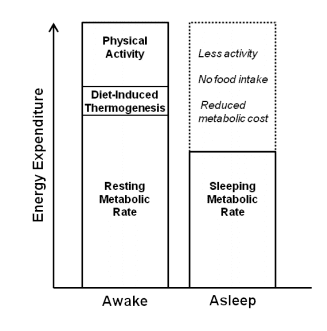Human energy expenditure (EE) is not stable over a 24 hour period, it has its own rhythm. It varies depending on the time of the day, the physical activity level and the exercise performed by the subject, the amount of food ingested and its composition. Human 24-hour EE is made up of several components. The different components can be identified as different stages of the 24h EE. It is possible to measure the different components of the 24-hour EE with indirect calorimetry (IC) equipment. In this web series, we will discuss and explain all EE components one by one. We start the series with the SMR, i.e. the sleeping metabolic rate.
What is Sleeping Metabolic Rate?
The definition of SMR varies among studies and researchers. One suggestion is to calculate the SMR at the lowest EE measured over the night and over three adjacent hours. An alternative approach is that SMR is determined by the energy expenditure during the time period when the amount of activity is lowest, usually over a period of three consecutive hours. When using the latter approach, equipment capable of measuring human movement needs to be implemented. These can be accelerometers or indoor motion sensor systems. Although SMR is sometimes determined by using a metabolic cart, the use of a whole room calorimeter (WRC) is much more common. These WRC systems are much more advanced and incorporate all the technical features and instrumentation to measure the subject under the most controlled environment conditions. An SMR measurement is a highly reproducible 24-hour EE component, with the lowest intra-subject day-to-day coefficient of variation. This offers great opportunities to determine metabolic effects within subjects very accurately.
Measurement sensitivities
When measuring SMR earlier in the night, the thermal effect of food (TEF) can be a confounding factor as TEF has an effect for at least four to six hours after the last meal. This could influence the measurement, as the EE decreases during sleep. For the assessment of SMR, this means that it varies from the early night (the EE would be higher) to the late night (the EE would be lower). This gradual decrease during the night is thus partly explained by the TEF component at the beginning of sleep. An SMR measurement has another limitation: the “first night effect”. This can lead to more periods of wakefulness. This can be easily solved by measuring at least two nights in a row, since after one night the sleep disturbances disappear.
More information and the recommendations for performing an indirect calorimetry measurement can be found in the RICORS 1.0 (Room Indirect Calorimetry Operating and Reporting Standards). An article written and compiled by specialists in the field.
Do you plan to measure Sleeping Metabolic Rate?
If you are interested to measure SMR please consult us about our Omnical indirect calorimetry metabolic cart (ventilated hood, sport and room calorimetry option), whole room calorimeter systems or accelerometry systems. Contact us or find more information on our information pages.
- Chen KY, Smith S, Ravussin E, Krakoff J, Plasqui G, Tanaka S, Murgatroyd P, Brychta R, Bock C, Carnero E, Schoffelen P, Hatamoto Y, Rynders C, Melanson EL. Room Indirect Calorimetry Operating and Reporting Standards (RICORS 1.0): A Guide to Conducting and Reporting Human Whole-Room Calorimeter Studies. Obesity (Silver Spring). 2020 Sep;28(9):1613-1625.
- Alcántara Alcántara, Juan Manuel. Assessment of resting energy expenditure and nutrient oxidation by indirect calorimetry: methodological implications. Granada: Universidad de Granada, 2021.
- Spaeth, Andrea Marie, “Consequences of Chronic Sleep Restriction on Energy Balance in Healthy Adults” (2014)

